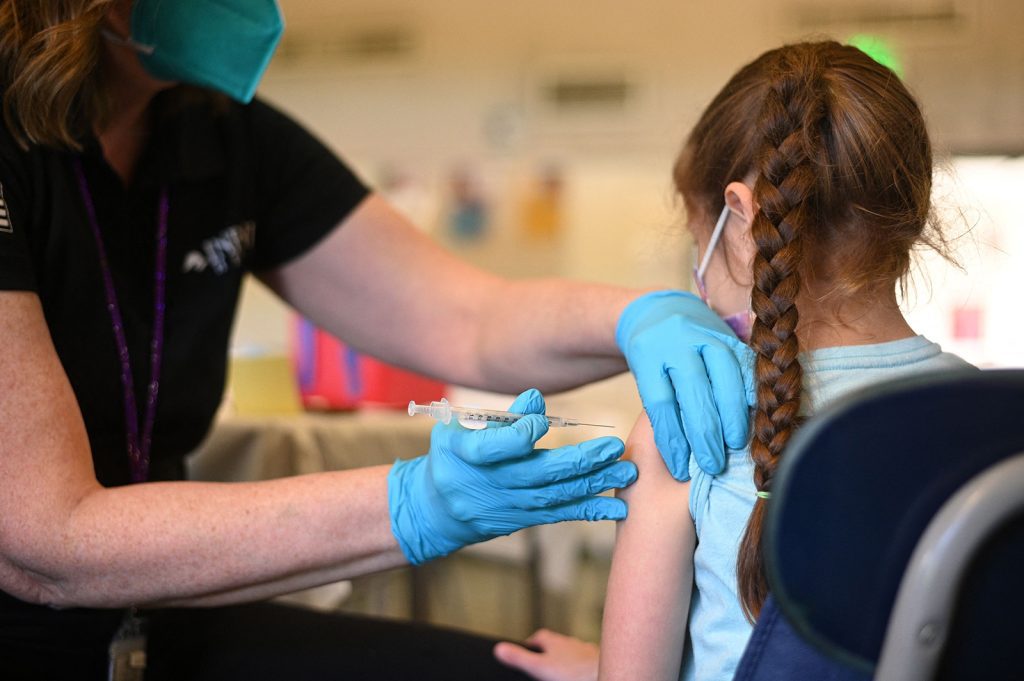April Dembosky, KQED | KFF Health News (TNS)
Almost all new parents experience the distress of hearing their child cry at the doctor's office. They go through the emotional torture of holding their child down as the clinician gives them one vaccine after another.
Remy Anthes, pushing her 6-month-old son, Dorian, in his stroller in Oakland, California, said, "The first shots he got, I probably cried more than he did."
Jill Lovitt recalled how her infant daughter Jenna reacted to some recent vaccines, saying, "The look in her eyes is hard to take. Like, 'What are you letting them do to me? Why?'"
Some children remember the needle pain and quickly start to internalize the fear. That's the fear Julia Cramer saw when her 3-year-old daughter, Maya, had to get blood drawn for an allergy test at age 2.
Julia Cramer said, "After that, she had a fear of blue gloves. I went to the grocery store and she saw someone wearing blue gloves, stocking the vegetables, and she started freaking out and crying."
Pain management research indicates that needle pokes may be children’s biggest source of pain in the health care system. The problem isn’t confined to childhood vaccinations either. Studies looking at sources of pediatric pain have included children who are being treated for serious illness, have undergone heart surgeries or bone marrow transplants, or have landed in the emergency room.
"This is so bad that many children and many parents decide not to continue the treatment," said Stefan Friedrichsdorf, a specialist at the University of California-San Francisco’s Stad Center for Pediatric Pain, speaking at the End Well conference in Los Angeles in November.
The distress of needle pain can follow children as they grow and interfere with important preventive care. It is estimated that a quarter of all adults have a fear of needles that began in childhood. Sixteen percent of adults refuse flu vaccinations because of a fear of needles.
Friedrichsdorf said it doesn’t have to be this bad. "This is not rocket science," he said.
He outlined simple steps that clinicians and parents can follow:
- Use an over-the-counter numbing cream, like lidocaine, 30 minutes before a shot.
- Comfort babies by breastfeeding or giving them a pacifier dipped in sugar water while they're getting a shot.
- Distract them with teddy bears, pinwheels, or bubbles to take their attention away from the needle.
- Rather than pinning kids down on an exam table, parents should hold children in their laps.
At Children’s Minnesota, Friedrichsdorf practiced the "Children’s Comfort Promise." Now he and other health care providers are rolling out these new protocols for children atUCSF Benioff Children’s Hospitalsin San Francisco and Oakland. He’s calling it the "Ouchless Jab Challenge". If a child at UCSF needs to get poked for a blood draw, a vaccine, or an IV treatment, Friedrichsdorf promises, the clinicians will do everything possible to follow these pain management steps. "Every child, every time," he said.The effort to make routine health care less painful may not convince people who are against vaccines because of conspiracy beliefs. However, it could help persuade hesitant parents to get their children vaccinated, as it may be less difficult to watch them in pain. This, in turn, may encourage adults who are not afraid of needles to seek preventive care, like the yearly flu shot..”
It will probably be up to parents to demand these measures at medical centers, as clinicians are accustomed to tolerating and accepting children's pain.
, a specialist in palliative care at Mount Sinai, agrees. She believes that doctors' tolerance for children's pain is a significant issue that stems from their training.
“We are trained to view pain as a regrettable but unavoidable result of good treatment,” Meier said. “We are taught to suppress our distress at causing pain in order to do our jobs.”
During her medical training, Meier had to restrain children for procedures, which she described as torture for both them and herself. This experience led her to move out of pediatrics and into geriatrics, and later to help lead
Diane Meiera current movement
to promote palliative care in medicine, which became an
official specialty in the United States in 2006. Meier thinks that the effort to reduce needle pain and anxiety should apply to everyone, not just children. “People with dementia do not understand why they are being approached with needles,” she said. And the experience can be painful and distressing. Friedrichsdorf’s techniques could also work with dementia patients, she said. This includes using numbing cream, distraction, something sweet in the mouth, and possibly playing music from their youth that they remember and can sing along to.
“It’s worth studying and giving serious attention to,” Meier said.
This article is part of a collaboration that includes
KFF Health News
KFF Health News
is a national newsroom that produces in-depth journalism about health issues and is one of the core operating programs of KQED , NPR , and — the independent source for health policy research, polling and journalism. .
(©2024 KFF Health News. Distributed by Tribune Content Agency, LLC. Roughly a quarter of all adults reportedly have a fear of needles that developed in childhood. Sixteen percent of adults decline flu vaccinations due to a fear of needles. KFF — the independent source for health policy research, polling and journalism.)
©2024 KFF Health News. Distributed by Tribune Content Agency, LLC.









